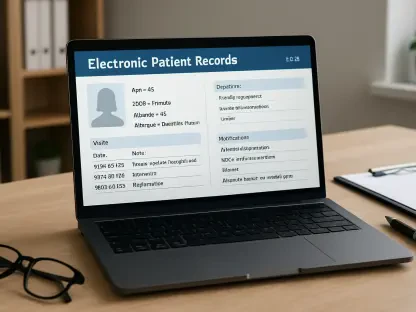South Africa’s healthcare system is navigating a critical juncture, balancing persistent inequities with promising avenues for transformation, as revealed by a comprehensive industry databook updated in Q2 2025. This extensive analysis, encompassing over 300 key performance indicators, dives deep into the nation’s healthcare ecosystem, shedding light on infrastructure, workforce dynamics, spending patterns, and demographic shifts. With historical data starting from 2020 and projections extending to 2029, the findings offer a vital resource for policymakers, investors, and healthcare professionals. The report underscores stark disparities between urban and rural care access, alongside challenges like workforce shortages and rising disease burdens. Yet, it also highlights opportunities for strategic interventions, such as in the pharmacy sector and digital health innovations. As South Africa grapples with these complexities, the data paints a picture of a system under strain but brimming with potential for meaningful reform.
Access Inequities in Focus
Urban-Rural Healthcare Divide
South Africa’s healthcare landscape is marked by a profound imbalance between urban and rural areas, where access to quality care remains heavily skewed toward city centers. Urban regions boast a higher density of private hospitals and pharmacies, often equipped with advanced technology and staffed by specialists, catering to a wealthier demographic. In contrast, rural communities rely predominantly on underfunded public facilities, which frequently lack essential resources like adequate staffing or modern equipment. This disparity not only limits timely medical interventions for rural populations but also exacerbates health outcomes for chronic and acute conditions. The data clearly illustrates that while urban patients might access multi-specialty hospitals with ease, rural residents often travel long distances for basic care, a reality that demands urgent policy attention to redistribute resources more equitably across the country.
Beyond the physical distribution of facilities, the urban-rural divide also manifests in the availability of preventive and diagnostic services, further deepening the access gap. Rural areas show a notable shortage of diagnostic centers and rehabilitation units, meaning early detection of diseases and post-treatment care are often out of reach for many. This creates a vicious cycle where preventable conditions escalate into emergencies due to delayed intervention. Meanwhile, urban centers continue to see growth in private sector investments, which, while beneficial for those who can afford it, do little to address the broader systemic inequity. Addressing this challenge requires not just building more facilities in underserved areas but also ensuring they are sustainably funded and staffed to meet local needs, a point emphasized by the databook’s extensive facility metrics.
Public vs. Private Sector Contrasts
The chasm between South Africa’s public and private healthcare sectors stands as a defining feature of the nation’s health challenges, with stark differences in quality and capacity evident across the board. Private facilities, often concentrated in urban hubs, typically offer superior infrastructure, shorter wait times, and access to specialized care, catering to a minority who can afford insurance or out-of-pocket payments. Public hospitals, tasked with serving the majority, frequently struggle with overcrowding, outdated equipment, and insufficient beds per 100,000 population. This imbalance places an immense burden on public systems, where patients may face delays in critical treatments, ultimately affecting health outcomes across socioeconomic lines. The disparity highlights a broader issue of equity that policymakers must tackle to ensure care is not dictated by financial status.
Moreover, the private sector’s dominance in certain regions skews resource allocation, pulling skilled professionals away from public institutions and compounding the strain on government-funded care. Data from the report indicates that private hospitals often outnumber public ones in terms of quality metrics, leaving rural and low-income urban communities with limited options. This dynamic perpetuates a two-tiered system where access to life-saving interventions can depend on one’s ability to pay rather than medical need. Bridging this gap calls for increased public investment and innovative partnerships that incentivize private entities to support underserved areas, ensuring that healthcare delivery aligns with the principle of universal access rather than market-driven priorities.
Workforce Challenges and Capacity
Regional and Specialty Shortfalls
A critical barrier to effective healthcare delivery in South Africa lies in the uneven distribution of medical professionals, particularly across regions and specialties. Rural areas suffer from a pronounced shortage of physicians and nurses, with ratios per 100,000 population falling well below urban benchmarks and regional averages. This scarcity often means that patients in remote areas lack access to even primary care, let alone specialized treatments for complex conditions. Certain medical fields, such as oncology and neurology, face acute deficits nationwide, limiting the system’s ability to address growing health demands. The data underscores how these imbalances threaten the sustainability of care delivery, especially in communities already grappling with limited infrastructure and resources.
Compounding the regional disparities is the challenge of retaining talent in high-need areas, where working conditions and compensation often fail to compete with urban or international opportunities. Many rural facilities operate with minimal staff, leading to burnout among existing workers and further deteriorating service quality. The report highlights that while urban centers may have a surplus of general practitioners, the lack of specialists in underserved regions creates bottlenecks in treating specific diseases. Addressing these gaps requires targeted recruitment drives, improved training programs, and incentives for professionals to serve in less desirable locations. Without such interventions, the healthcare system risks perpetuating cycles of inadequate care in the areas that need it most.
Brain Drain and Workforce Demographics
South Africa’s healthcare workforce faces a significant threat from the migration of skilled professionals seeking better prospects abroad, often referred to as the brain drain. This trend depletes the pool of experienced physicians, nurses, and allied health workers, particularly in a country already struggling with staffing shortages. Many leave due to limited career advancement, lower pay, or challenging working conditions in the public sector, opting for opportunities in Europe, North America, or Australia. The loss of talent not only strains existing resources but also undermines long-term efforts to build a robust healthcare system capable of meeting rising demands. This issue, evident in the databook’s workforce metrics, calls for urgent strategies to make local careers more appealing.
Additionally, demographic trends within the medical workforce reveal further complexities, such as gender and age imbalances that could impact future capacity. While a relatively young cohort of professionals offers hope for long-term growth, the underrepresentation of certain groups in key roles may limit diversity in care approaches. The data suggests that without retention policies—such as competitive salaries, mentorship programs, and improved workplace environments—the brain drain will persist, disproportionately affecting rural and public sector facilities. Policymakers must prioritize creating a sustainable pipeline of talent through education and incentives, ensuring that the healthcare system can withstand both current shortages and future demographic pressures.
Financial Dynamics and Policy Needs
Escalating Costs and Funding Shortfalls
Healthcare spending in South Africa is witnessing a consistent rise in per capita costs, driven by factors like an aging population, increasing prevalence of chronic illnesses, and medical inflation. Projections from 2025 to 2029 indicate steady growth in expenditure on hospital care and physician services, reflecting the intensifying demand for medical resources. However, this upward trajectory is not matched by adequate public funding, leading to a heavy reliance on private insurance and out-of-pocket payments, especially among lower-income households. This financial burden exacerbates inequities, as many cannot afford necessary treatments, resulting in delayed care or worsening health conditions. The data emphasize the urgent need for sustainable funding mechanisms to alleviate the strain on vulnerable populations.
Furthermore, the imbalance in funding sources creates a fragmented system where access to care often hinges on economic status rather than medical necessity. Public healthcare budgets struggle to keep pace with rising costs, leaving facilities under-equipped and understaffed, particularly in rural areas. The report points to a critical gap in achieving universal health coverage, as out-of-pocket expenses continue to dominate for essential services like diagnostics and medications. Addressing this requires innovative approaches, such as expanding public-private partnerships or introducing progressive taxation models to bolster government healthcare allocations. Without such reforms, the financial pressures will likely deepen existing disparities and hinder progress toward equitable care.
Regional Comparisons and Economic Benchmarks
When benchmarked against regional peers, South Africa’s healthcare expenditure as a percentage of GDP reveals a concerning shortfall, signaling challenges in achieving comprehensive health coverage. While spending is increasing, it remains below levels seen in comparable economies, limiting the country’s ability to address systemic issues like infrastructure deficits and workforce shortages. This gap is particularly evident in public health initiatives, where funding constraints restrict preventive care and disease management programs. The databook’s comparative analysis highlights that without aligning expenditure with regional standards, South Africa risks falling further behind in health outcomes and system resilience, especially amid growing demographic and disease burdens.
This economic disparity also reflects broader structural challenges, including inefficiencies in resource allocation and policy implementation that prevent the optimal use of available funds. While some neighboring countries have made strides in universal coverage through targeted investments, South Africa’s reliance on private funding sources continues to undermine equity. The data suggests that closing this gap demands not only increased budgetary commitments but also strategic reforms to enhance spending efficiency. Exploring models like risk-pooling mechanisms or international aid partnerships could provide the necessary financial boost. Such measures, grounded in regional lessons, are essential to ensure that healthcare investments translate into tangible improvements for all citizens.
Population Trends and Health Demands
Aging Society and Life Expectancy Concerns
Demographic shifts in South Africa, particularly an aging population, are placing unprecedented pressure on the healthcare system, as older adults often require more frequent and complex medical interventions. This trend, coupled with declining life expectancy in certain groups due to preventable conditions like hypertension and diabetes, signals a critical need for enhanced primary care and public health strategies. The data projects a growing demand for geriatric services and chronic disease management from 2025 to 2029, straining already limited resources. Without proactive measures to address these shifts, such as expanding community health programs or increasing specialist training in age-related care, the system risks being overwhelmed by the needs of an older demographic.
Additionally, the socioeconomic factors contributing to reduced life expectancy in vulnerable populations underscore the intersection of health and inequality. Poor access to nutritious food, clean water, and timely medical care in underserved communities exacerbates preventable mortality rates, highlighting the urgent need for action. The report’s demographic analysis calls for targeted interventions, such as mobile clinics and health education campaigns, to mitigate these risks. Investing in preventive measures now can reduce the long-term burden on hospitals and improve overall population health metrics. The urgency of addressing these trends lies in their ripple effects, as healthier aging populations contribute to economic stability and reduced healthcare costs over time.
Dual Burden of Disease Challenges
South Africa faces a unique health challenge with the simultaneous prevalence of non-communicable diseases, such as heart disease and cancer, and infectious diseases like tuberculosis and HIV/AIDS, creating a dual epidemic that strains the healthcare system. This combination places immense strain on healthcare resources, as each category demands distinct approaches to prevention, treatment, and management. Patient admission rates, rising due to both population growth and unmet needs, reflect the severity of this burden across various age and gender groups. Hospitals, especially in the public sector, often struggle to allocate beds and staff effectively between acute infectious cases and long-term chronic care, highlighting the need for specialized facilities and integrated health strategies to tackle both fronts simultaneously.
Moreover, the dual disease burden reveals systemic weaknesses in early detection and ongoing care, particularly for non-communicable conditions that require consistent monitoring. Infectious diseases, while historically prioritized due to their immediate threat, continue to divert resources from chronic illness programs, perpetuating a cycle of reactive rather than preventive care. The databook’s patient statistics emphasize that addressing this challenge necessitates a balanced approach, such as strengthening primary healthcare to catch issues early and reduce hospital admissions. Investments in public awareness and screening initiatives could shift the focus toward prevention, easing the load on overstretched facilities and ensuring that neither disease category is neglected in resource planning.
Pathways to Progress and Innovation
Expanding Pharmacy Market Opportunities
The pharmacy sector in South Africa emerges as a dynamic area of growth, with prescription revenues showing a steady increase and signaling significant market potential for investors and policymakers alike. Urban areas, where most pharmacies are concentrated, benefit from this expansion, providing easier access to medications and related services for city dwellers. However, this growth also mirrors broader access inequities, as rural regions remain underserved, often lacking even basic pharmaceutical outlets. The data suggests that optimizing distribution channels to reach remote areas could not only improve health outcomes but also unlock economic opportunities by tapping into unmet demand. This sector’s trajectory offers a chance to address systemic gaps through strategic planning and investment.
Beyond revenue growth, the pharmacy market presents an opportunity to enhance overall healthcare delivery by integrating services like vaccinations and health consultations at the community level. Such initiatives could alleviate pressure on hospitals by managing minor ailments and chronic conditions locally. However, the challenge lies in overcoming logistical barriers, such as supply chain inefficiencies and regulatory hurdles, that hinder rural expansion. The report advocates for public-private collaborations to incentivize pharmacy chains to establish outlets in less profitable areas, potentially through subsidies or tax breaks. Leveraging this sector’s potential requires a concerted effort to ensure that growth translates into equitable access rather than reinforcing existing urban biases.
Infrastructure and Digital Health Solutions
Strategic investments in healthcare infrastructure, particularly in the public sector, stand as a cornerstone for addressing South Africa’s systemic challenges and improving care delivery across the board. Public hospitals and clinics, often plagued by underinvestment, need significant upgrades in bed capacity, equipment, and facility standards to meet rising demand. The data highlights slow expansion in diagnostic and rehabilitation centers, which limits preventive and post-acute care, especially outside urban zones. Prioritizing capital expenditure in these areas, alongside building new facilities in underserved regions, can help close the access gap and ensure that quality care is not confined to private, urban-centric systems. Such efforts are essential for creating a more resilient healthcare framework.
In parallel, embracing digital health solutions offers a transformative pathway to enhance efficiency and reach in South Africa’s healthcare system. Telemedicine, electronic health records, and mobile health applications can bridge geographical barriers, providing remote consultations and real-time data to rural patients and providers alike. The report suggests that investing in technology infrastructure, alongside training for healthcare workers to adopt these tools, could revolutionize service delivery. However, challenges like digital literacy and internet access in remote areas must be addressed to ensure inclusivity. Combining physical infrastructure upgrades with digital innovations presents a dual strategy to modernize the system, reduce strain on facilities, and improve health outcomes for all South Africans through sustainable, forward-thinking reforms.
Reflecting on Data-Driven Healthcare Strategies
Looking back, the comprehensive analysis of South Africa’s healthcare landscape provided a sobering yet actionable perspective on the state of the system as captured in the Q2 2025 databook update, highlighting persistent challenges and potential solutions. Disparities between urban and rural access, alongside the public-private divide, stood out as persistent hurdles that shaped inequitable health outcomes. Workforce shortages and the brain drain of skilled professionals revealed vulnerabilities in capacity, while rising spending pressures underscored financial sustainability concerns. Demographic shifts and the dual disease burden further highlighted the complexity of meeting diverse health needs. Moving forward, stakeholders must prioritize targeted infrastructure investments, focusing on underserved public facilities to balance resource distribution. Leveraging the pharmacy sector’s growth and adopting digital health tools can amplify reach and efficiency. Additionally, innovative funding models and retention policies for medical staff are critical next steps to build resilience. These strategies, grounded in the report’s data, offer a blueprint for transforming challenges into opportunities for a more equitable and robust healthcare future.









